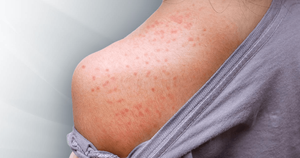Diagnostic Tests and Differential Diagnosis
Key Indicators
Unless pathognomonic signs are present or symptoms consistent with measles appear during a local outbreak, diagnosing measles based on clinical signs alone is challenging. Laboratory testing thus remains essential for an accurate diagnosis. Although common in the past, diagnosis by isolation of measles morbillivirus (MeV) in cell culture is both time-consuming and costly and has now become obsolete. When faced with a patient presenting with an acute febrile rash illness (i.e., a suspected case of measles), the two best confirmatory diagnostic options are:
- Serologic testing for measles immunoglobulin M (IgM) antibody; and
- Molecular testing for MeV RNA by polymerase chain reaction (PCR).
Recommended tests and appropriate samples for the diagnosis of acute disease and for testing of measles immunity are shown in Figure 2-3.
Serologic testing for immunoglobulin M (IgM) is usually done by enzyme immunoassay on blood samples, which has a sensitivity of 83-89% and a specificity of…
To continue reading
Log in or register to continue reading. It's free!
OR
By signing up to create an account, I accept Healio's Terms of Use and Privacy Policy.
Key Indicators
Unless pathognomonic signs are present or symptoms consistent with measles appear during a local outbreak, diagnosing measles based on clinical signs alone is challenging. Laboratory testing thus remains essential for an accurate diagnosis. Although common in the past, diagnosis by isolation of measles morbillivirus (MeV) in cell culture is both time-consuming and costly and has now become obsolete. When faced with a patient presenting with an acute febrile rash illness (i.e., a suspected case of measles), the two best confirmatory diagnostic options are:
- Serologic testing for measles immunoglobulin M (IgM) antibody; and
- Molecular testing for MeV RNA by polymerase chain reaction (PCR).
Recommended tests and appropriate samples for the diagnosis of acute disease and for testing of measles immunity are shown in Figure 2-3.
Serologic testing for immunoglobulin M (IgM) is usually done by enzyme immunoassay on blood samples, which has a sensitivity of 83-89% and a specificity of 95-99%. However, in up to 20-25% of measles-infected patients will not have detectable levels of IgM antibodies within 72 hours after the onset of rash. Furthermore, IgM antibodies may be absent or only transiently present in vaccinated individuals and a negative IgM test result cannot be used to rule out measles infection in these patients.
Real time PCR-based methods, which detect MeV RNA with a sensitivity of 94% and a specificity of 99%, play an increasingly important role in confirming a tentative diagnosis of measles. Adequate samples for PCR-based detection include swabs (throat, nasal, or posterior nasopharyngeal), bronchial lavage samples and urine samples. While respiratory specimens are preferred, testing the urine increases the chance of establishing a diagnosis.
Note that a positive result from any molecular or serologic test, including MeV isolation, can only be taken to indicate natural measles in the absence of vaccination for measles in the preceding 6-45 days, since measles vaccines contain live-attenuated MeV virus. Thus, a positive PCR result in the setting of mild measles-like illness may simply indicate recent vaccination.
In addition to measles, the differential diagnosis of fever and rash includes other viral infections (enterovirus, adenovirus, parvovirus, human herpesvirus-6, Epstein-Barr virus and dengue), tick-borne rickettsial disease and drug reactions.
Differentiating Kawasaki disease from measles is critical since timely treatment of the former is essential to avoiding coronary artery sequelae.

References
- Bellini WJ, Helfand RF. The challenges and strategies for laboratory diagnosis of measles in an international setting. J Infect Dis. 2003;187 Suppl 1:S283-S290.
- Bharti N, Tatem AJ, Ferrari MJ, Grais RF, Djibo A, Grenfell BT. Explaining seasonal fluctuations of measles in Niger using nighttime lights imagery. Science. 2011;334(6061):1424-1427.



